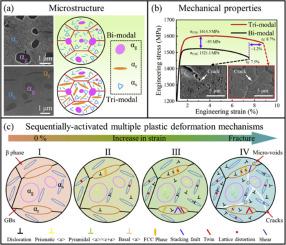Sequentially-activated multiple deformation mechanisms enable a hierarchically duplex titanium alloy with high strength-ductility synergy
IF 9.3
1区 材料科学
Q1 MATERIALS SCIENCE, MULTIDISCIPLINARY
引用次数: 0
Abstract
The HCP α-precipitates in duplex titanium (Ti) alloys are quite important to their mechanical properties in terms of accommodating plastic deformation for large ductility on the one hand and hindering dislocation motion for high strength by α-precipitate/β-matrix interfaces on the other hand. However, the intrinsic limited slip systems of low symmetric α-precipitates lead to progressive deformation localization even cracking due to high stress concentrations, becoming the origin of the strength-ductility conflict in Ti alloys. Here, a tri-modal Ti-4.5Al-4.5Mo-7V-1.5Cr-1.5Zr (wt.%) alloy as a model is decorated by hierarchically multi-scaled and multi-polymorphic α precipitates to introduce multiple plasticity mechanisms for high strength-ductility synergy. The sequentially-activated plasticity mechanisms (SAPMs) dominantly involve prismatic 〈a〉 and pyramidal 〈c + a〉 dislocation slip and cross-slip in globular micron-αg, the P-type HCP-to-FCC transformation and stacking faults/nanotwins in rod-like submicron-αr, and prismatic 〈a〉 dislocation slip transfer in secondary nano-αs. The SAPMs in the α precipitates are strongly size-dependent and explained in terms of the critical resolved shear stress (CRSS). The contribution of multi-polymorphic α-precipitates to the yield strength is quantified with their distinguished strengthening capabilities of α-precipitates in multi-scales. The present hierarchical Ti alloy with the tri-modal microstructure achieves a good combination of yield/ultimate tensile strength of 1550/1614 MPa and ductility of ∼8.7 %.


顺序激活的多种变形机制使分层双相钛合金具有高强度-延性协同作用
双相钛(Ti)合金中的HCP α-析出相一方面可以容纳塑性变形,从而获得较大的延展性,另一方面可以通过α-析出相/β-基体界面阻碍位错运动,从而获得较高的强度,这对双相钛(Ti)合金的力学性能有重要影响。然而,低对称α-析出相的本征限滑系统由于高应力集中导致逐渐变形局部化甚至开裂,成为钛合金强度-塑性冲突的根源。本文以三模态Ti-4.5Al-4.5Mo-7V-1.5Cr-1.5Zr (wt.%)合金为模型,采用分层多尺度多晶α相装饰,引入多种塑性机制,实现高强度-延性协同。顺序激活的塑性机制主要包括球状微米-αg中的棱柱形<;a>;和锥体<;c+a>;位错滑移和交叉滑移,棒状亚微米-αr中的p型hcp - fcc转变和层错/纳米孪晶,次级纳米-αs中的棱柱形<;a>;位错滑移转移。α析出相中的sapm具有很强的尺寸依赖性,可以用临界分解剪切应力(CRSS)来解释。通过α-相在多尺度上的显著强化能力,量化了多晶型α-相对屈服强度的贡献。所制备的分层钛合金具有三模态组织,其屈服/极限抗拉强度为1550/1614 MPa,塑性为~ 8.7%。
本文章由计算机程序翻译,如有差异,请以英文原文为准。
求助全文
约1分钟内获得全文
求助全文
来源期刊

Acta Materialia
工程技术-材料科学:综合
CiteScore
16.10
自引率
8.50%
发文量
801
审稿时长
53 days
期刊介绍:
Acta Materialia serves as a platform for publishing full-length, original papers and commissioned overviews that contribute to a profound understanding of the correlation between the processing, structure, and properties of inorganic materials. The journal seeks papers with high impact potential or those that significantly propel the field forward. The scope includes the atomic and molecular arrangements, chemical and electronic structures, and microstructure of materials, focusing on their mechanical or functional behavior across all length scales, including nanostructures.
 求助内容:
求助内容: 应助结果提醒方式:
应助结果提醒方式:


